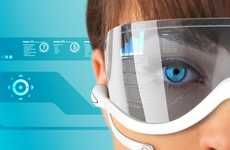
Cinema 3D Will Allow Moviegoers to Watch 3D Films Without Glasses
References: wisdom.weizmann.ac.il & theverge
Cinema 3D, a newly released technological innovation developed by researchers at MIT's Computer Science and Artificial Intelligence Lab, promises to bring moviegoers their spectacular 3D blockbusters without forcing them to wear special glasses. While glasses-free 3D imaging exists in portable video game devices and on TVs, those systems require users to view the screen from a very precise distance and angle, one that can't be replicated in a theater full of people. Cinema 3D solves that problem with a screen system that presents 3D images to every seat in a theater.
The key to the technology is in the fact that, once viewers are seated for a movie, they don't need to move. Researchers seized on this immobility, using a system of "parallax barriers" and mirrors to mimic the previous technology but apply it each seat in the house, effectively giving each viewer a personalized 3D experience.
By reducing the costs associated with 3D eyewear, Glasses-free 3D movies could lower the price of viewing a 3D film, ultimately bringing more people into the theater.
The key to the technology is in the fact that, once viewers are seated for a movie, they don't need to move. Researchers seized on this immobility, using a system of "parallax barriers" and mirrors to mimic the previous technology but apply it each seat in the house, effectively giving each viewer a personalized 3D experience.
By reducing the costs associated with 3D eyewear, Glasses-free 3D movies could lower the price of viewing a 3D film, ultimately bringing more people into the theater.
Trend Themes
1. Glasses-free 3D Imaging - Disruptive innovation opportunity: Develop glasses-free 3D technology for various applications beyond movies, such as gaming, virtual reality, and medical imaging.
2. Personalized 3D Experience - Disruptive innovation opportunity: Create personalized 3D experiences in other entertainment industries like theme parks, live performances, and interactive exhibitions.
3. Cost Reduction - Disruptive innovation opportunity: Explore cost-effective solutions to make 3D movies more accessible in education, training simulations, and architectural visualization.
Industry Implications
1. Entertainment Technology - Disruptive innovation opportunity: Combine 3D imaging technology with immersive entertainment experiences in theme parks, museums, and arcades.
2. Healthcare - Disruptive innovation opportunity: Utilize glasses-free 3D imaging in medical applications for improved diagnostics, surgical planning, and patient education.
3. Education - Disruptive innovation opportunity: Integrate glasses-free 3D visualizations in educational tools and platforms to enhance learning experiences for students.
1.1
Score
Popularity
Activity
Freshness























